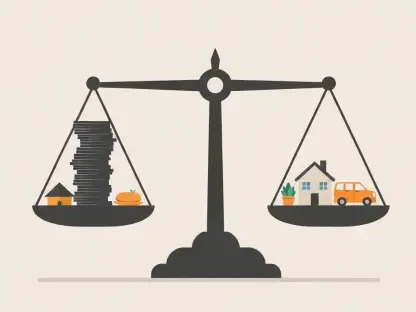The re-election of Donald Trump has set the stage for significant changes in U.S. banking regulation. With a focus on business-friendly policies, the financial sector is poised for a shift that could impact traditional banks, fintech companies, and regulatory bodies like the Consumer Financial Protection Bureau (CFPB). This article delves into the anticipated regulatory changes and their implications for various stakeholders.
Business-Friendly Policies and Their Impact
Easing Constraints on Traditional Banks
Under Trump’s administration, traditional banks are expected to experience a loosening of regulatory constraints. This shift aims to reduce oversight and create a more conducive environment for growth and innovation. The potential benefits include increased efficiency and expanded services. However, the reduction in oversight also brings inherent risks that require careful monitoring. The less stringent regulatory framework could lead to increased profitability for banks but might also result in unchecked risk-taking and financial instability.
Financial institutions may take advantage of the deregulation by expanding services and engaging in more speculative activities. While this could drive economic growth in the short term, it might also expose consumers to greater financial risks. For example, with reduced regulatory oversight, banks may be more inclined to offer high-risk loans, potentially leading to higher default rates. Additionally, the competitive pressure to innovate may push banks to integrate new technologies rapidly without proper vetting, further amplifying systemic risks. The challenge lies in striking a balance between fostering innovation and maintaining financial stability, ensuring that the benefits of deregulation do not come at the expense of consumer safety and market integrity.
Implications for Mergers and Acquisitions
The regulatory environment under a Republican administration is likely to facilitate mergers and acquisitions (M&A) within the banking sector. The proposed ‘shot clock’ bill, which limits the time regulators take to review mergers, exemplifies this trend. Streamlined merger reviews could lead to faster consolidation, raising questions about market concentration and consumer choice. While higher efficiency is a potential benefit, reduced competition could negatively impact lending rates and service quality for consumers.
As banks merge and grow larger under a more lenient regulatory regime, there is a risk of increased systemic importance and market dominance of a few major players. This concentration of power can stifle competition, leading to fewer options for consumers and potentially higher costs for banking services. Moreover, larger financial institutions may become “too big to fail,” increasing the likelihood of government bailouts in times of financial distress. Policymakers and regulators will need to monitor these developments closely to ensure that market consolidation does not undermine the competitive landscape and adversely impact consumers. The challenge will be to foster an environment where growth and innovation can thrive without compromising the fundamental principles of fair competition and consumer protection.
The Rise of Fintech and Regulatory Adjustments
Introduction of a Fintech Charter
A significant shift could come from the introduction of a fintech charter, allowing fintech companies to engage in payments processing without relying on bank partnerships. This move would enhance fintechs’ market reach and operational independence, fostering innovation and competition in financial services. However, the reduction in regulatory burdens may dilute oversight over fintechs, posing risks related to consumer protection and data privacy. The fintech charter, while promising for growth, necessitates a careful balance to ensure that the drive for innovation does not compromise financial stability and consumer rights.
Granting fintech companies greater autonomy through a charter could accelerate advancements in financial technology, resulting in more efficient and personalized services. Yet, the absence of traditional oversight mechanisms could also open the door to potential abuses, such as inadequate data security measures or exploitative lending practices. Regulators must tread carefully to establish a framework that encourages fintech innovation while maintaining rigorous oversight to protect consumers. Collaborative efforts between regulatory bodies, fintechs, and traditional banks will be essential in crafting policies that support technological progress without sacrificing the safeguards that preserve market integrity and trust.
Partnerships Between Fintechs and Banks
Partnerships between fintechs and banks have faced challenges in complying with anti-money laundering regulations and consumer protection standards. Trump’s administration might ease this pressure, enabling fintechs to grow through collaborations without stringent oversight. The potential emergence of a certification program for fintechs, allowing voluntary compliance with certain standards, could effectively lower the compliance bar while maintaining some safeguards. This could lead to a surge in fintech-bank partnerships, driving innovation and expanding financial services access.
However, reduced regulatory scrutiny might also result in gaps that bad actors could exploit, posing risks to the financial system. The balance between fostering innovative partnerships and ensuring robust compliance with consumer protection and anti-money laundering regulations will be critical. Ensuring that these partnerships do not compromise ethical standards or consumer protection will be paramount in maintaining both market integrity and public trust. By establishing clear guidelines and accountability measures, the financial sector can benefit from the efficiencies and innovations brought forth by fintech-bank collaborations while safeguarding against potential abuses.
Changes in Consumer Protection and Data Rights
The Future of the CFPB
Under the Biden administration, the CFPB actively enforced consumer protections, implementing caps on late credit card fees and levying record fines against violators. In contrast, Trump’s administration is likely to scale back these efforts, focusing less on pursuing cases of unfair or deceptive practices. This anticipated reduction in oversight may appeal to banks and fintechs, but risks undermining consumer protections established in recent years. The shift could lead to a regulatory environment where financial institutions operate with greater freedom, potentially at the expense of consumer rights and transparency.
As the CFPB’s enforcement rigor wanes, consumers might face a landscape where predatory practices and unfair fees become more prevalent. While reducing regulatory burdens can empower financial institutions to innovate, doing so without adequate consumer safeguards can lead to harmful consequences. Policymakers must carefully consider the implications of reducing oversight and work towards a balanced approach that promotes healthy industry growth while protecting consumer interests. Maintaining transparency, accountability, and fair practices within the financial sector will be essential to ensure consumer trust and stability.
Potential Delays to the CFPB’s 1033 Rule
The CFPB’s new 1033 rule, which grants consumers greater control over their banking data, has bipartisan support. However, traditional banks have already filed lawsuits against its implementation. Trump’s pro-business stance suggests that the administration might delay or weaken the rule, affecting fintechs reliant on consumer data to offer personalized services. If litigation stalls the rule, fintechs may struggle to provide integrated, data-driven financial services, hindering innovation in consumer finance.
Delays in implementing consumer data rights can have far-reaching effects on both consumers and fintech companies. Consumers may find it challenging to access personalized financial services that rely on comprehensive data analysis, while fintechs may face obstacles in leveraging data to innovate and compete effectively. Balancing the interests of traditional banks with the need for consumer control over personal data will be a complex but necessary task for regulators. Ensuring that data privacy and consumer rights are upheld will be crucial in fostering a trustworthy financial ecosystem where innovation can thrive without compromising individual privacy and security.
Judicial Influence on Regulatory Authority
Supreme Court Rulings and Regulatory Challenges
Recent Supreme Court rulings that curtail federal agencies’ authority to interpret ambiguous laws add to the regulatory uncertainty. This judicial environment may encourage financial institutions to challenge CFPB rules, further limiting the agency’s enforcement power. Such a ‘regulatory chill’ could lead to more conservative approaches by regulatory agencies, reducing the scope of consumer protections. The shifting judicial landscape underscores the need for clear, well-defined regulations that balance innovation with robust consumer protection and oversight.
Financial institutions may see these rulings as opportunities to push back against regulatory constraints, potentially leading to a less stringent compliance environment. However, this judicial trend could embolden financial institutions to engage in practices that might harm consumers or destabilize the market. Regulators must navigate this challenging environment by formulating clear, enforceable rules that can withstand judicial scrutiny while protecting consumer interests. The goal should be to create a regulatory framework that encourages innovation and growth without compromising market stability and consumer trust.
Impact on Financial Institutions and Consumers
Donald Trump’s re-election marks a pivotal moment for U.S. banking regulations, promising a wave of substantial changes. Emphasizing business-friendly strategies, his administration is likely to reshape the financial landscape, impacting not only traditional banks but also fintech companies and regulatory bodies like the Consumer Financial Protection Bureau (CFPB). These anticipated shifts could bring about a more lenient regulatory environment, potentially stimulating growth and innovation within the sector. However, there are concerns about how these changes might affect consumer protections and financial stability. By analyzing the expected regulatory adjustments, this article explores their broader implications for various stakeholders involved, including banks, fintech firms, and consumers. The evolving landscape could lead to a more competitive and dynamic market, with both positive outcomes and challenges to navigate. Understanding the potential effects of these policy changes is crucial for all parties as they adapt to the new regulatory framework under Trump’s continued leadership.









